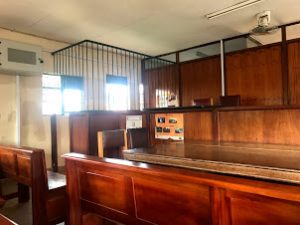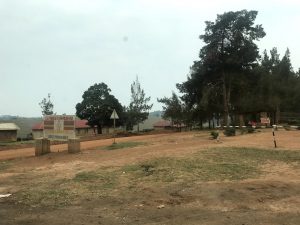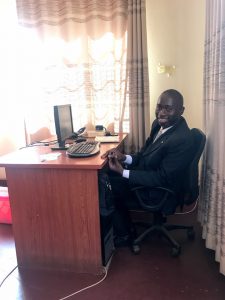By Katrina Bland
“You have to wear a long skirt, for the security of the inmates.”
The day before our visit to Muinaina Prison, I was told that a woman is not allowed to enter a prison in Uganda if she is not wearing a skirt. What else did I know about prisons in Uganda? Almost nothing.
I had spent the last couple days reading a report from a partner organization, Interaid, about refugee clients in Luzira Prison in Kampala that they wanted Refugee Law Project to take on. The report described each prisoner’s country of origin, their charges, sentence, and their requests. While many requested help with their appeals, a prison transfer, or to contact their families, every single one requested the basic necessities of cooking oil and rain boots. I had also heard people say that conditions in prison in Uganda are awful, and likely responsible for the country’s low recidivism rate of 30%—the lowest in Africa. In the car during the three-hour drive to Muinaina from Kampala, I went over these clues in my mind. First, I had to wear a skirt. Second, the inmates want cooking oil and rain boots. Third, the conditions are so bad no one wants to go back.
With these clues, I unsophisticatedly adapted an image of North American prisons in my mind. Muinaina would be, I thought, the same, but the incarcerated persons might do their own cooking and the courtyard would be mud instead of cement. I wrote off the third clue because it’s difficult to imagine any prison anywhere where the conditions would be such that people would leave wanting to return.
For most of the drive from Kampala, we had no idea where Muinaina Prison was. We stopped for directions three times, and each time we were simply told to keep driving. The tarmac road turned to dirt, but the same open hills of green tea plants and matoke rolled by. Suddenly, or so it seemed to me, my colleagues breathed sighs of relief and announced our arrival. What gave them that idea? As I looked around, I saw nothing that indicated a prison. There was no massive parking lot or ten-metre high wall, no buildings made of flat grey cement with barred windows. Then I spotted a man in a bright yellow uniform with a herd of cows. Then another man in a bright orange uniform carrying a bundle of firewood. And a group of ten men in yellow carrying sacks of maize. A group in mixed yellow and orange tilling a field. They were prisoners, but there were no guards to be seen.
As we got closer what I thought was just another collection of houses surrounding a school turned out to be the prison staff quarters around the inmates’ wards. We went in, gave the name of the client we were there to see and were shown to a wooden bench looking into a courtyard through a gate. Nearby, three or four guards stood talking. They were the first security personnel I had seen in Uganda without guns. There was no privacy, but we were not searched or asked any questions. A guard simply called to an inmate near the gate to tell our client that he had visitors. I realized that it is not surprising Muinaina does not have the fluorescent lit visiting room that I had pictured during the journey there. The prison is so remote; it is difficult to imagine visitors are more than a rare occurrence.
When our client appeared dressed in yellow, he sat on an identical wooden bench on the other side of the gate bars and described his case. Yellow is the colour for incarcerated persons on remand, while orange is the colour for those who have been convicted—at least most of the time. These days, prisons often run out of yellow uniforms due to the huge number of persons incarcerated waiting trial. They make up more than 50% of Uganda’s prison population and many are relegated to the orange of convicted persons.
Much like the lack of information about the whereabouts of Muinaina Prison, RLP had been referred our client’s case without any details. This is not uncommon. RLP has eleven offices across Uganda serving thousands of clients who often do not have permanent phone numbers, residences, or in some cases, even birthdates. RLP staff at other offices refer the vague details of a potential client and my supervisor, Jesse, sets out into the field and hopes for the best.
Our client told us he had been incarcerated for over three months. Originally, he was told he would be brought to court for a bail hearing on June 11th, but the day of, the guards told him he wasn’t going. He hadn’t heard anything since. No one was surprised by this story. The prison is so remote that there is no internet or cell service there. Communication to and from the prison is difficult and expensive. Just as family members of incarcerated persons do not know where they are or how they are, the incarcerated persons themselves are usually not informed of the status of their file or when they will get to appear in court. There is no broad promise of legal aid in Uganda, and without an advocate on the other side any information is difficult to come by.

As my colleagues interview our client, in a mixture of Congolese Swahili and Luganda, I watch as the courtyard comes to life. Inside, there only appears to be one guard, distinguishable among the sea of orange and yellow by his beige uniform. The incarcerated persons sat in three neat groups, two of yellow and one of orange. Surrounding each group were three or four other individuals in yellow or orange, each carrying a long skinny stick. While the single prison guard appeared to chat amicably with them, they seemed to be the ones in charge.
The colour doesn’t seem to matter, however, in Uganda’s overpopulated prison system. Uganda has 249 prisons, with a maximum carrying capacity of 16 612 individuals. The most recent statistics say that the total population of these prisons is 48 422, exceeding their maximum capacity by over 30 000 people. Individuals on remand are not separated from those convicted and those convicted of the most serious offences are not treated any differently than the rest. Muinaina is only one prison among these 249, but as the inmates get up and move around it is not difficult to see how overcrowded the facilities are and how impossible it would be to separate offenders by their crime or sentence.
Without any signal or instruction, some men begin sorting through maize, separating kernels and putting them through a grinder to create maize flour. Others begin cooking in a corner. Some men work at a makeshift carpentry station under the branches of a young tree. One man in yellow discusses something with the guard and then uses a saw to cut a long branch off of another small tree. This man then appears to be able to wield the same authority as the other men in orange and yellow overseeing the activities in the courtyard. No one objects. The sticks do not appear to be threatening at all. Granted I cannot hear or understand anything that is being said, they seem almost like a wooden pointer in a classroom, used to indicate or just to hold, imparting a sense of confidence and status to the bearer.
Along the edges of the courtyard are two long single-story buildings with many doors. While the centre of the courtyard is bustling with activity, men on the edges sit on the doorsteps or lean against the walls of these buildings. They look like they are waiting for something and have been waiting so long they have run out of things to talk about. Many watch us intently from afar as we interact with our client. Soon, without warning, the men return to their original three groups of yellow and orange sitting on the ground. After a short while, they get up and work or wait again. And then return to their groups. And repeat.
The Ugandan Prison Service (UPS) promotes farm prisons like Muinaina as self-sufficient entities that teach inmates agricultural skills they can use when they are released. It is one of many rehabilitation programs that has been promoted by the UPS since the Prisons Act was passed in 2006. In a way, what I saw presented a much more believable version of rehabilitation than what I know of prisons at home. There was no trace of the North American version of incarceration where individuals are surrounded by cement above and below as well as on all sides or where a fight between inmates or bad behaviour is punished with solitary confinement. Instead, Muinaina seemed to function like a small village, replicating life outside the prison quite well. At the same time, the shortage of resources is evident. Indeed, it is probably the shortage of resources that makes this style of prison both possible and necessary.
The government does not have the funds to provide food, so the inmates must grow and cook their own. Other shortages, like space, medical services, and clean water reported in Ugandan prisons, however, are less possible for prisons to remedy on their own. Even worse, there are reports of torture and ill-treatment, especially among individuals incarcerated on remand as guards are charged with securing confessions to push cases forward. The difference between forced labour as punishment and agriculture as a rehabilitative program may be impossible to observe in such a short visit. For individuals waiting for a trial date that may never come in Uganda’s backlogged and bureaucratic judicial system, all of these conditions—no matter how rehabilitative—violate their fundamental rights.

It is colder at Muinaina than in Kampala, cold enough to remind me of a late September evening at home, and the sky is dark with coming rain. When it rains, it will get colder and the ground will turn to clay. The ten men carrying sacks of maize return from the fields. The guards unlock the three padlocks keeping the prison gate closed, and the men run in, deposit their maize in a pile and run out again. They repeat this three times in the period we are there. Some of these men have uniforms including pants or a sweater, while others wear only shorts and a t-shirt. Many of these men are barefoot, while others are wearing the much coveted rain boots.
As we drove away, I asked Jesse why no one seems worried about the men escaping. They seem free to graze cattle as far from the prison as they wish or to disappear into tall fields of maize unsupervised. Jesse asked me in return, where would they go? My response of ‘anywhere’ only made him laugh. Their yellow or orange uniforms make them visible from so far away, they would need to run naked. Moreover, many of them are safer here than at home as traditional justice in their villages sometimes means wrongdoers must be killed for the sake of peace. Besides, he said, the guards know the prisoners aren’t stupid. They could be out of here any day, so why would they run?


